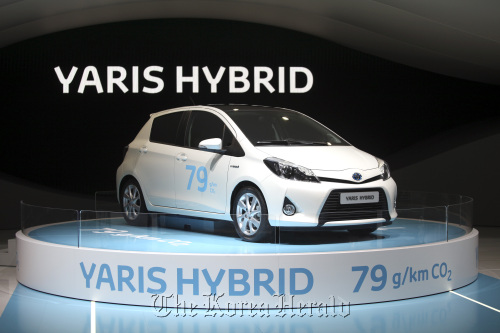 |
A Toyota Yaris Hybrid sits on display during the Geneva International Motor Show in Switzerland. (Bloomberg) |
Toyota Motor Corp., which was overtaken by Volkswagen AG in sales last year, is striking back on the German automaker’s home turf.
Toyota is rolling out Europe’s first hybrid subcompact and the image-boosting GT86 sports coupe this year in a bid to claw back market share in the region after sales plunged 41 percent since 2007. The Toyota City, Japan-based company will further bolster its European business by outfitting its vehicles with diesel engines from Bayerische Motoren Werke AG from 2014.
“It’s unacceptable for Toyota to be at this volume level in Europe,” Didier Leroy, Toyota’s European chief, said in an interview. By cutting management layers to streamline decision- making over the past two years, “we made ourselves much leaner, much more agile. We strongly went for the fighting spirit in everything we do.”
That shakeup is likely to pay off this year, with Toyota predicting its first profit in Europe in five years. Market share in the European Union is set to rise to 6.6 percent from 5.7 percent last year, while the VW brand slips to 18.2 percent from 18.5 percent, according to data from IHS Automotive. By making gains in Europe, Toyota aims to halt VW’s march to become the world’s biggest automaker, overtaking General Motors Co.
Toyota lost the top spot last year when disruptions caused by the earthquake in Japan and the lingering effects of global recalls in 2009 and 2010 caused the maker of the Camry sedan to drop to third as VW leapfrogged Toyota to become number two.
“The real issue for Toyota is winning back customers,” said Jonathon Poskitt, head of European sales forecasting at LMC Automotive in Oxford, England. “Toyota really needs to refocus on the requirements of what are sophisticated European customers that already have a great choice in new vehicles.”
The hybrid version of the Yaris, which competes with VW’s Polo, is part of the campaign. Production on the gas-electric subcompact started at Toyota’s factory in Valenciennes in northern France earlier this week after an investment of 25 million euros ($33 million). The hybrid variant of Toyota’s European best-seller gets the equivalent of 76 miles per gallon.
On the other end of the scale is the GT86, which accelerates to 100 kilometers per hour in as little as 8.2 seconds and sports a low-slung grill and dual exhaust pipes. The aggressive design is meant to challenge VW’s Scirocco and PSA Peugeot Citroen’s RCZ and pep up Toyota’s image.
Impressing the Neighbors
The brand’s current models “haven’t seemed to capture the customer’s imagination,” said Ian Fletcher, an analyst at IHS Automotive in London. The GT86 “might be a car that brings people back into the showroom.”
That’s just what Fredrik Bjorklund, who heads a Stockholm- based chain of Toyota stores, is yearning for, when the car goes on sale later this year. It hits German showrooms in September.
“We’re hoping it will be a fantastic image creator for us,” Bjorklund said. “Toyota has received criticism for its non-thrilling design, and we must get people to think it’s fun with Toyota so that when your neighbor sees it he gets interested.”
Still, with hybrids lacking widespread acceptance in Europe and Toyota targeting a modest 15,000 GT86 deliveries in the region, the Japanese carmaker will need to do more to reach its goal of selling over one million cars in Europe, Russia, Turkey and Israel, 20 percent more than its 2012 target of 835,000.
Facing tough competition and lacking in-demand technology, Toyota’s performance in Europe has declined faster than elsewhere. In 2007, when Toyota’s sales reached a record of 9.37 million vehicles, deliveries in Europe accounted for 13 percent of the total. Last year, Europe accounted for 10 percent of Toyota’s 7.95 million auto sales globally.
BMW Engines
“Toyota’s strengths are in hybrid cars, and this has led to strong sales in the United States and markets that are sensitive to increases in gasoline prices,” Satoru Takada, a Tokyo-based analyst at Toward the Infinite World Inc. “Europe is already dominated by the German carmakers, because diesel cars are popular. Eastern Europe is one area where Toyota may be successful, but every company is targeting those markets, so competition there will be tough for Toyota too.”
A lift in Europe could come when BMW starts delivering diesel engines to Toyota in two years. Diesel, which is taxed less than gasoline in many European countries, fueled nearly half of the new cars sold in Germany last year. BMW agreed to supply Toyota with diesel engines in Europe as part of a cooperation pact on research into next-generation batteries.
‘A Bit Boring’
Toyota’s thrust in Europe comes as the Wolfsburg, Germany- based manufacturer makes a push in the U.S., where the Japanese company outsold VW five-to-one in 2011. Volkswagen last year opened a $1 billion factory in Tennessee to build as many as 150,000 Passat sedans a year.
Toyota’s improved finances in Europe are in stark contrast to some rivals. Ford Motor Co. predicted a loss of as much as $600 million in Europe in 2012. GM lost $747 million in Europe last year and is considering further cost cuts.
Even with the improvements, gaining and holding onto customers in VW’s home region will remain a challenge. At the Toyota dealership in Stockholm, Johan Lindgren, a 31-year old biochemist who owns a RAV4 sports-utility vehicle, is keeping his eyes open to replace his 2001 Yaris Verso.
“My Toyotas have been very reliable and practical,” he said. “The design has improved lately but is still a bit boring. For the next one, I’ll consider Toyota and other brands.”
(Bloomberg)








